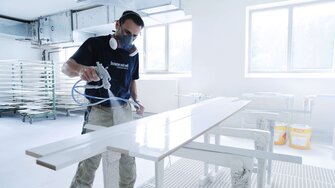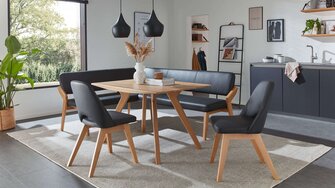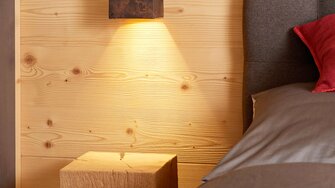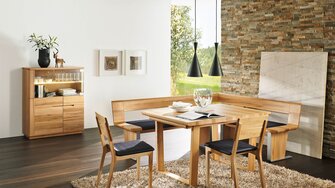Switching to water-based coatings: minor obstacles, big opportunities
Nowadays, many carpenters and joiners are considering switching to water-based paints and varnishes – and for good reason: water-based paint and varnish systems are environmentally friendly and better for our climate; they offer clear advantages in terms of health and safety, and are also attractive from an economic point of view. But how much organisational effort is involved in the changeover? What investments are necessary? And do water-based paints and varnishes really offer the same quality? Manuel Mathes, application and training expert at Austrian paint and varnish manufacturer ADLER, has already helped many customers with the switch to water-based coatings, so he has a good understanding of the key factors involved. He provides answers to the most important questions in an interview:
19 Jun 2024
What are the arguments in favour of switching to water-based paints and varnishes?
It's actually quite simple: water-based coatings have no relevant disadvantages, but on the other hand offer many advantages. They are good for the environment and help to protect our climate; they are good in terms of health and safety during use; they are straightforward when it comes to storage and disposal, and in terms of quality, they are at least on a par with solvent-based products. And another very important point: in most cases, they are also noticeably cheaper!
To what extent?
Although the price per kilo is generally a little higher for water-based paints and varnishes, this is more than compensated for by the smaller quantities required. The quantity needed is on average approx. 30 g/m2 lower due to the higher solids content. In addition, water-based paints and varnishes can usually be applied as single-component coatings – another important cost factor. Our experience shows that using ADLER water-based paints and varnishes results in a significant reduction in costs. And that's without including any additional costs: water-based paints and varnishes can simply be diluted with water, the consumption of cleaning agents is halved because they can be mixed 1:1 with water, and the quantity of materials disposed of is also significantly reduced.
And are water-based paints and varnishes really that much more environmentally friendly?
The VOC content of water-based paints and varnishes is ten times lower than that of solvent-based paints – ADLER's new Bluefin Unistar clear varnish is even completely VOC-free. Solvent from paints and varnishes is released into the air in the form of emissions, not only during painting and drying, but for several weeks afterwards, depending on the ventilation conditions. These solvent emissions are known to pollute the environment and cause damage to our climate; in closed rooms they can irritate the mucous membranes, and they are also responsible for unpleasant odours, which may in turn lead to complaints from neighbours for companies that use them. The production of solvent-based paints and varnishes is also very resource-intensive, as the raw materials are largely petroleum-based. There is also a risk of fire or explosion – which is why there are strict regulations regarding the storage of solvent-based coatings. None of this applies if you use water-based coatings.
But are there other health risks?
No, quite the opposite. At ADLER, we generally use raw materials that are as non-toxic and harmless as possible and avoid using any substances that are hazardous to the environment or to human health. The monomeric isocyanate content of all our hardeners is below the threshold of 0.1%, and their extremely low VOC content means that water-based paints and varnishes produce only minimal emissions. All this has been confirmed by independent organisations. The results clearly show that our water-based paints and varnishes are completely safe to work with, as long as they are used correctly. Worries about respirable aerosols or sanding dust are also unfounded, providing the necessary occupational safety measures are complied with, e.g. goggles, combi-filter masks or air extraction systems – this applies to both water-based coatings and solvent-based coatings.
Despite all this, many carpenters are hesitant to make the switch because they are worried about the high level of investment that may be involved.
In my experience, the expense involved is usually much less than had been feared beforehand, as most of the existing infrastructure can continue to be used. At ADLER, we see ourselves as a problem-solving partner for our customers. Not only do we provide them with top-quality water-based coatings, our technical sales team also gives them support throughout the entire changeover process: we take a look at their coating area together and advise customers on any changes that are needed; we train the team in the use of water-based paints and varnishes – and if they do need any painting equipment, customers can purchase it directly from ADLER.
What exactly is needed?
Water-based coatings require the use of stainless steel spraying equipment – but this is largely standard today anyway. We usually recommend that customers purchase a new spray gun with hoses and that they keep the old spray gun for occasions when a solvent-based paint has to be used. They will also need a new set of nozzles – slightly larger nozzles are required for water-based coatings – and a coagulation set, which is used to separate solids from water-based paint or varnish residues. The costs for all these purchases are in the low four-figure range.
Are any additional adaptations needed in the drying area?
Water-based coatings are somewhat more sensitive to temperature and humidity. Ideally, the room temperature should be between 20 and 25°C with a humidity of between 40 and 65%. Often the conditions in the drying area already meet these requirements so no changes need to be made. In other cases, small measures are sufficient – such as a fan or a humidifier, which also provides the necessary air movement. There is of course plenty of scope for further, more sophisticated measures, such as a modern drying cabin or an infrared drying system – but the changeover can also be made with very simple means.
Speaking of drying: how long does this take?
The difference in comparison to solvent-based paints and varnishes is only slight with today's water-based coating systems. ADLER's Bluefin Unistar can be sanded and recoated after just two hours, putting it on a par with most solvent-based paints. Other water-based coatings, such as the coloured paint Bluefin Pigmores 4in1 or the clear varnish Bluefin Softmatt and the versatile water-based wood stain Arova Flex take between 4 and 5 hours.
What else is different in the painting or varnishing process?
Not very much. Basically you just have to pay attention to a few points. The glue used must be compatible with water-based coatings and, for woods rich in active ingredients, such as oak, a suitable clear varnish is required. In addition, when using water-based stains on solid oak, the wood should be soaked in water beforehand to prevent the wood fibres from raising up. Ultimately, the key point is to ensure that you apply the correct quantity, i.e. you will need to apply less coating than is usual with solvent-based products – applying the incorrect quantity is the most common cause of coating problems. All of this can easily be learnt in a day or two. At ADLER, we offer a seminar on this subject at our service centres – or we can come directly to the company and train employees on site.
How do water-based coatings perform when used as 2C products?
In most cases, this question doesn't even arise, as water-based paints are often applied as single-component products – and this is usually adequate. ADLER's 1C furniture varnish Bluefin Resist, for example, creates such a durable and resilient surface that it can also be used for kitchen furniture or in hotel or school interiors. This makes it simpler to apply and saves money. Some water-based coatings have a slightly shorter pot life of approx. 5 hours when used as two-component products, but this can be enough time with a little planning – and Bluefin Unistar, already mentioned above, has a pot life of as long as 3 days, thanks to an innovative cross-linking technology!
The question remains: Are water-based paints also just as good in terms of quality?
There are still stories going around in many companies of water-based paints or varnishes that soften or go yellow when touched frequently, for example. This may have been the case 30 years ago, but these things have long since ceased to be an issue with today's coating systems. As far as ADLER's products are concerned, I can guarantee that there are no differences in quality, in terms of either chemical and mechanical resistance or colour stability. ADLER's extensive range includes water-based paints and varnishes for any area of application, any substrate and any desired look – right through to special effect paints such as our real metal coatings.
Does this mean that any surface can be realised using either water-based or solvent-based coatings?
By and large, yes. Our Research & Development department at ADLER is currently working on closing the last remaining gaps, e.g. in water-based high-gloss coating systems.
Does this also apply to oiled surfaces?
Solvent-based products are still very popular for oils, even in companies who work with water-based coatings. This is not a problem in practice, as oils are usually applied by hand anyway and are not subject to the Decopaint guidelines because they are applied in only very thin coats. However, water-based oils such as our Legno Aqua-Öl are also becoming increasingly popular – this product can also be sprayed on and does a perfect job of preserving the raw wood character of reclaimed wood, for example, thanks to its low degree of grain accentuation. Incidentally, with clear varnishes too, water-based coatings usually have a lower level of grain accentuation, which is very much in line with the current trend towards natural, matt surfaces. And if a strong accentuation is required, there are also suitable solutions – the Aquafix UV 100 additive, for example, not only offers excellent protection against yellowing, but also increases the grain accentuation of all ADLER's standard water-based coatings.
So your conclusion is that switching to water-based paints and varnishes means little additional expense and no disadvantages.
Exactly – but there are lots of advantages: you'll save money and you won't have to worry about the risk of fire in the paint store. Using the coatings is safer and more pleasant, and you won't have to deal with the aggressive odour of solvents. Wood is a natural material and you'll be giving it a matching eco-friendly coating, something that customers will also appreciate. And of course, set against the backdrop of environmental and climate protection, switching to water-based paints and varnishes is the only way to go!
ADLER – paint runs through our veins
With 720 employees, ADLER is Austria's leading manufacturer of varnishes, paints and wood preservatives. Founded in 1934 by Johann Berghofer, this family business is now managed by a member of the third generation, Andrea Berghofer. Every year, 21,000 tonnes of paint leave the Schwaz plant and are delivered to customers in more than 30 countries worldwide. ADLER has sales subsidiaries in Germany, Italy, Poland, the Netherlands, Switzerland, the Czech Republic and Slovakia; their sole production site is the ADLER-Werk Lackfabrik in Schwaz, Tyrol (Austria). ADLER was one of the first companies in its sector to be 100% climate-neutral (since 2018). The company has been able to reduce its carbon footprint to a minimum through a wide range of measures. ADLER offsets any unavoidable residual emissions through the purchase of recognised climate protection certificates, thereby helping to finance new climate protection projects
© by adler-lacke.com




